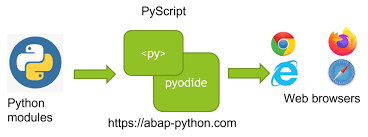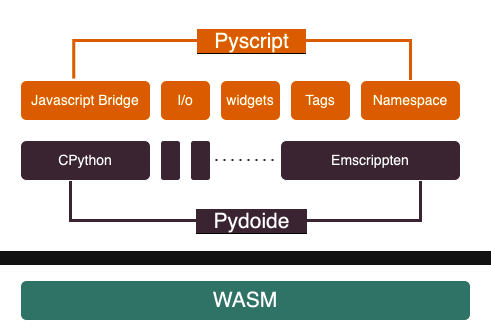Python has traditionally held its position in backend web development, supported by robust frameworks such as Django and Flask. However, a new framework called ‘PyScript’ opens up new horizons by allowing you to run Python alongside JavaScript on the front end. This ground-breaking integration not only expands the versatility of Python but also streamlines the development process, allowing for a more cohesive and efficient web development experience.
Imagine how useful it would be to create elegant websites using Python. It sounds amazing, right? So let’s get started.
Understanding PyScript
At its core, PyScript positions itself as a tool for seamlessly incorporating Python into HTML, similar to the functionality of PHP. It empowers web development with Python, enables the use of JavaScript libraries, and facilitates embedding Python code in HTML. At its core is the Pyodide Python interpreter, constructed in WebAssembly, a modern web language. Anaconda’s CEO, Peter Wang, unveiled this innovative approach at PyCon 2022.

How PyScript is Useful for the World and Data Scientists?
PyScript is not only beneficial for developers; it also caters to data scientists, offering them a platform to create web applications using their data. With the capacity to create web apps using their data, data scientists may now take advantage of the web’s accessibility to a wider audience. With interactive dashboards and models packaged in an HTML file, sharing findings and insights becomes effortlessly streamlined.
Understanding the Mechanism of PyScript
PyScript is built on Pyodide, a CPython-to-WebAssembly/Emscripten port. It is a Python distribution for the browser, and Node.js is based on WebAssembly.

- Pyodide runs Python packages in a web browser using micro-pip
- Pydoide has a JavaScript/Python interface for mixing both languages
- Earlier, only JavaScript could run natively in web browsers
- WebAssembly (WASM) is a new option for running any programming language in a web browser.
The Magic of WebAssembly
WebAssembly is a game-changing technology that lets programmers utilize Python to create web pages. Developers can compile code written in the human-readable .wat text format into the .wasm binary format, which allows for direct execution in web browsers. Writing code in any programming language and running it smoothly on the web is now possible, thanks to this innovative method.
Emscripten: It’s a complete WebAssembly compiler tool chain based on LLVM (Low Level Virtual Machine), with a focus on speed, size, and the Web platform.
Why Choose PyScript?
PyScript distinguishes itself from other programming languages by offering a language that is easy to learn, expressive, and has uniform stylistic principles. Its bidirectional JavaScript and Python object and namespace communication provides a dynamic and adaptable development environment.
Benefits of PyScript
Ecosystem Support: PyScript uses popular Python packages such as Pandas, Numpy, and many more.
Python with JavaScript: Bidirectional object and namespace communication between Python and JavaScript
Flexible Framework: A versatile framework for creating and sharing new pluggable and extensible components directly in Python
Environment Management: Enable users to specify which packages and files should be included for the page code to run.
Visual application development: Develop visually appealing applications by utilizing pre-built, curated UI components like buttons, containers, text boxes, and more.
Unlocking Python’s Power in Web Development with PyScript
PyScript is a useful tool in the ever-changing web development as it provides a fresh way to integrate Python into online projects. Let’s look at some real-world scenarios where PyScript can improve the development process.
Data-Driven Dashboards:
Suppose you have been entrusted with creating a dashboard for a client’s analytics platform that visualizes data.
- To handle data processing and visualization, utilize PyScript to embed Python code within HTML.
- Use Python tools such as Matplotlib and Pandas directly in the front-end to create dynamic dashboards based on data.
Personalized Content Recommendations:
Imagine you are developing an online store, and you need to give users individualized product recommendations.
- Run Python code for customized recommendation systems by integrating PyScript with HTML.
- Retrieve and process user data instantly for a personalized purchasing experience without extensive backend modifications.
From dynamic dashboards to collaborative coding, PyScript brings Python’s power to the forefront of web innovation.
Conclusion
PyScript enables Python for frontend web development by compiling it into WebAssembly. It retains core Python syntax, supports asyncio/await for asynchronous programming, and offers interactive usage in browsers. With comparable performance to JavaScript, PyScript allows the reuse of Python skills and libraries, making it a powerful tool for front-end development. This is an excellent resource for anyone interested in using Python on the web. You can play and explore with PyScript.





